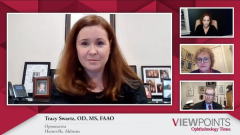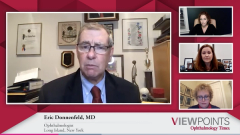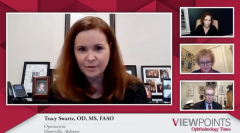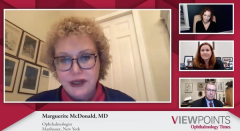
Epidemiology and consequences of untreated dry eye
Episodes in this series

Marguerite McDonald, MD: Crystal, can you tell us why it’s important to recognize and treat dry eye?
Crystal Brimer, OD, FAAO: Absolutely. What I’ve seen in my practice is exactly what Eric just said: The prevalence is growing. Basically, if you’re looking for it, it’s practically every patient, so much that I have ended up doing just dry eye. At that point I recognized how much of an impact the rest of the world and their lifestyle has on dry eye and vice versa. This correlation between depression, anxiety, and sleep quality and dry eye, and then…the diet: inflammatory foods, anti-inflammatory foods. I saw not only all the things that contribute to the negative outcome but also how much the negative outcome affected patients. I was seeing more severe patients, to the point where I probably had 5 patients say they wanted to commit suicide, which is a big deal. If we’re taking on the full responsibility that we should, we’ve got to realize how big of an impact it has. It affects every aspect of their lives. When they feel it every time they blink, there is no forgetting about it during the day.
Patients who are much earlier in that journey don’t realize how progressive it can be, and that’s also our responsibility, to help them understand that you may be able to tolerate it and deal with it the way it is, but this is not the end. If you do nothing, it’s going to get worse and it’s going to look and feel a lot different from how it does now
Marguerite McDonald, MD: Tracy, what are the consequences of untreated dry eye. In other words, what’s the risk of progression?
Tracy Swartz, OD, MS, FAAO: Dry eye starts with the hyperosmolarity, and then you get the damage to the ocular surface, the goblet cells, and the epithelial cells, which increase inflammation, and then you develop tear film instability. Then the reduced tear film breakup time exacerbates the hyperosmolarity, and then you get an increase in physical symptoms with inflammation and patient discomfort. The patient just gets caught in that cycle.
The problem is we’re going to throw in problems like ocular allergy and ocular surface disease. For contact lens wearers, topical drops may contain preservatives. Plus, eye makeup and skin creams—we don’t want wrinkles, so women are using skin creams to reduce the wrinkles. We’re wearing masks that are going to further reduce that tear breakup time. This cycle is not going to get broken unless eye care practitioners do something to stop it.
We need to address ocular surface disease in middle age, identify a peak increase in dry eye disease in the 40s and 50s. Left untreated, these eyes are going to become inflamed. They’re going to become red and itchy, and the patients are going to have trouble with debris in their lashes and conjunctivochalasis causing a foreign-body sensation. They’ll have more trouble with debris in the lashes. Chronic inflammation can result in trichiasis and madarosis. We can develop things like lid wiper epitheliopathy, causing a foreign-body sensation, entropion, margin thickening, and scarring of the meibomian gland. Corneal diseases might include severe keratopathy with reduced best-corrected visual acuity, neovascularization, ulcers, and corneal melts.
We’ve been saying this for years, but a lot of dry eye goes untreated, so I thought that I might take a slightly different direction. What if we consider the way dry eye is directly affecting us, the eye care practitioners? Consider contact lens dropout and increased emergencies in your office because of contact lens complications, or persistent blurry vision affecting spectacle prescriptions resulting in redos, which affect your bottom line. Patients who might feel their symptoms were ignored are going to go somewhere else. They’re going to go to a different office. We have to consider that noncandidacy due to dry eye can reduce the number of patients pursuing LASIK, and we might have increased LASIK enhancement if we’re having refractive shift due to dry eye after surgery. Errors in IOL [intraocular lens] measurement can lead to refractive errors after surgery and make your patients unhappy, and we’re going to make more patients unhappy if we increase their dry eye disease.
Marguerite McDonald, MD, Eric Donnenfeld, MD, Tracy Swartz, OD, MS, FAAO, and Crystal Brimer, OD, FAAO, discuss a number of topics pertaining to dry eye, including the diagnosis and clinical manifestations, traditional, treatment options, and the potential new agents in the horizon.
Newsletter
Don’t miss out—get Ophthalmology Times updates on the latest clinical advancements and expert interviews, straight to your inbox.























































